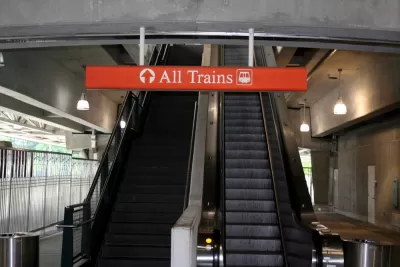Atlanta needs federal funding to make its light rail and bus service dreams a reality, but it already has $2.5 billion in sales tax revenue to work with.

Thomas Wheatley reports from Atlanta, where MARTA officials recently presented their vision for spending the $2.5 billion in funding approved by voters in 2016 through a .5 percent sales tax.
The largest investment in Atlanta transit since MARTA was built more than 40 years ago would add light rail, express buses to some of the city’s most congested corridors, and at least two “transit centers,” potentially shaping the development of the auto-oriented city for generations to come.
For more detail on the light rail portion of that vision, Wheatley adds:
According to a work session presentation obtained by Atlanta magazine, the MARTA tax funding would be spent on light rail lines along a portion of the segments of the Atlanta BeltLine in both southwest and northeast Atlanta. Light rail would also connect the Lindbergh station to Emory University, providing people another way to access the Clifton Corridor, one of the region’s largest job centers that is not near an interstate or currently served by rail transit. Two east-west light rail lines would also connect to the downtown streetcar, effectively linking the south and north segments of the BeltLine with transit. Finally, Greenbriar Mall in far southwest Atlanta would connect to MARTA’s Oakland City rail station via a light rail line.
The article includes maps of the proposed light rail lines, early details on proposed improvements to bus routes and the proposed transit centers, and one big glass of cold water: the vision described during the working session would require matching funds from the federal government.

Maui's Vacation Rental Debate Turns Ugly
Verbal attacks, misinformation campaigns and fistfights plague a high-stakes debate to convert thousands of vacation rentals into long-term housing.

Planetizen Federal Action Tracker
A weekly monitor of how Trump’s orders and actions are impacting planners and planning in America.

San Francisco Suspends Traffic Calming Amidst Record Deaths
Citing “a challenging fiscal landscape,” the city will cease the program on the heels of 42 traffic deaths, including 24 pedestrians.

Defunct Pittsburgh Power Plant to Become Residential Tower
A decommissioned steam heat plant will be redeveloped into almost 100 affordable housing units.

Trump Prompts Restructuring of Transportation Research Board in “Unprecedented Overreach”
The TRB has eliminated more than half of its committees including those focused on climate, equity, and cities.

Amtrak Rolls Out New Orleans to Alabama “Mardi Gras” Train
The new service will operate morning and evening departures between Mobile and New Orleans.
Urban Design for Planners 1: Software Tools
This six-course series explores essential urban design concepts using open source software and equips planners with the tools they need to participate fully in the urban design process.
Planning for Universal Design
Learn the tools for implementing Universal Design in planning regulations.
Heyer Gruel & Associates PA
JM Goldson LLC
Custer County Colorado
City of Camden Redevelopment Agency
City of Astoria
Transportation Research & Education Center (TREC) at Portland State University
Jefferson Parish Government
Camden Redevelopment Agency
City of Claremont




























